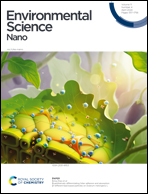Mechanistic description of lead sorption onto nanoplastics†
Abstract
Although it is currently recognized that nanoplastics (NPs) are present in the environment, their ability to carry metals or other contaminants and the processes involved are still poorly investigated. Yet, one of the significant threats of plastic debris is found in these associated species. The lack of relevant data is directly explained by our inability to collect enough nanoplastics from the environment for experimental investigation. The models of environmental NPs that we have recently proposed offer new opportunities to characterize their interactions with metals. We have developed an adsorption model based on lead (Pb2+) adsorption experiments (adsorption isotherm at pH 5.5 for Pb(II)/NP ratios between 0.5 and 100 mg gC−1 and a pH adsorption edge between pH 2 and 8 for Pb(II)/NPs at 2.5 and 25 mg gC−1 relative to the studied NPs, ionic strength = 5 mmol L−1 NaNO3) using various NP models to describe surface complexation processes and to predict the sorption capacity of NPs. Model hypotheses have suggested that Pb is adsorbed onto NPs via carboxylic sites mainly as mono-ligand and bi-ligand complexes. The empirical model and linear free energy relationship validated the extrapolated stability constants and binding hypothesis. The adsorption capacities of nanoplastics are highly dependent on their surface oxidation state, shape heterogeneity and aggregation which control their carboxylic site density, distribution and then availability. This metal–NP affinity suggests that NPs could act as vectors of metals relative to their behavior regarding other natural adsorbent phases.



 Please wait while we load your content...
Please wait while we load your content...